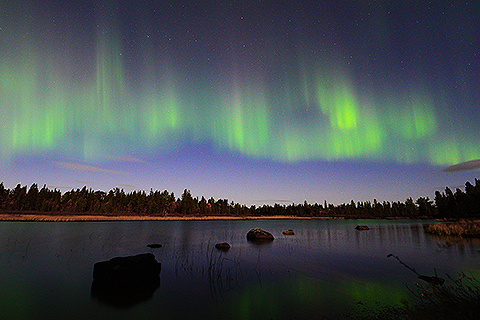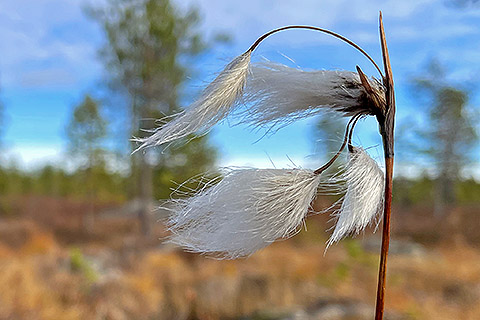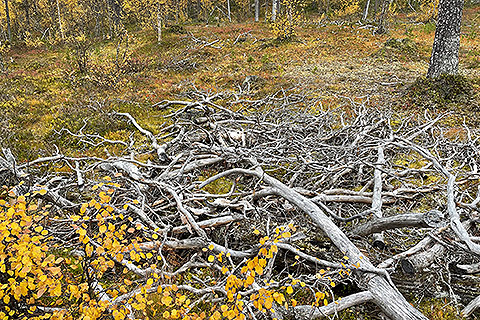|

September was my second
opportunity to combine remote work and DXing in
Lapland. For the first week I was working during
daylight hours, when there would be nothing to listen
to. During the second week I was off work, but spent
time checking and improving our antennas, and focused
on DXing especially around sunrise and sunset. I
expected new catches mostly from Australia, but
propagation favored higher latitudes, so most of
my interesting catches were from the U.S. and China.
As it had been 32 years since I last joined my friend
Martti
Karimies (MKA) for a DXpedition to Lapland (KAMU6),
another joint DXpedition was long overdue. Martti
is a renowned expert on DXing AM stations from the
Eastern Hemisphere, so I was eagerly looking forward
to us hunting for new stations from Australia and
Indonesia. September should have been the ideal
time of the year for these AM stations.
Unfortunately, propagation conditions
didn't support the plan. Martti had arrived in our
Aihkiniemi
DX cabin already five days earlier, during which
time he did get several rarities from Australia
(such as 3KND Melbourne on 1503 AM), but as soon
as I showed up, nothing much of interest was heard
from Down Under.
Mostly I focused on just
keeping tabs of the changing propagation, and getting
the best openings recorded by my Perseus receivers.
By the time of publishing this report, I have only
reviewed about 2 % of my recordings, so there should
be some goodies left to discover. In any case, it
is safe to say that the total amount of new catches
will be significantly lower than on my previous
DXpedition AIH133
in February.

This could be my
best aurora shot ever, thanks to the shooting star
in the frame. CLICK to enlarge.
September is the time of the year when the outdoors
in Lapland actually looks exceptionally photogenic,
which is why my haul of photos might eclipse the
very modest discoveries on the AM dial. On one clear
night the northern lights were pretty impressive,
and I sent a few of my shots to the meteorologist
on duty at my employer, the Finnish Broadcasting
company YLE. They ended up in the main evening newscast
on TV, and I was very pleased to be able to share
them with a wider audience also
on Facebook.
Because of the fall colors, September is the most
popular hiking season in Lapland, and so the trains
were full, forcing me to drive north. It is 1,200
kilometers (745 miles) from the capital region to
Aihkiniemi, too much for me to drive in one day
– especially on top of a full work day. Happily
I was able to stay overnight at the riverfront cottage
of my friend and fellow DXer Jari Ruohomäki
and his spouse Ritva in Tervola, just south of the
Arctic Circle.

Jari and Ritva at the
breakfast table.
On Friday, September 17, I was able to leave home
a bit past 3 PM, later than planned, which got me
stuck in heavy Friday afternoon traffic on the freeway
number 4 (E-75) to Lahti for the first hour. Gradually
the traffic became easier, and I took the first
and only hamburger break at the ABC service station
in Pyhäjärvi after four hours and 40 minutes
of driving. When I was ready to continue, it was
past 8 PM, and already pretty dark, so after the
pit stop there was no more sightseeing. Not that
there would be much to see before Oulu, as this
stretch of the highway is quite flat and boring.
It was already midnight
when I arrived at the cabin of Ritva and Jari, but
fortunately they didn't mind my late arrival. We
had a great time catching up over wine and a late
dinner, and it was close to 4 AM before I got to
bed.
On Saturday morning it was time
to take a look at the surroundings of the cabin,
located on the shore of Kemijoki, the mightiest
river in Finland. BTW, the shot behind the headline
of this report is taken from there, at the riverfront
of the cabin. At this point the river is about 600
meters wide. After a sumptuous breakfast I finally
got driving north just before midday.

Crossing over Kemi River on the Jätkänkynttilä
Bridge in the town of Rovaniemi.
I shopped for groceries and filled
up in Ivalo where I also had a sandwich for lunch.
Incidentally, I ran into four fellow DXers at the
Ivalo S-Supermarket parking lot. What a rare coincidence!
A pack of wolves, as the DXers from Northern Karelia
call themselves, happened to be visiting Jari Korhonen's
DX cabin in Ivalo on this same weekend.

A chance encounter in
Ivalo. From left: Mika Mäkeläinen, Markku
Sollo, Jussi Suokas, Jari Korhonen and Jopi Nyman.
Driving was relaxing on dry roads without too many
campervans slowing me down. Not too many reindeer
either. I arrived in Aihkiniemi at 6 PM, which under
ordinary conditions would have been far too late
to take advantage of any Asia opening, but propagation
was poor, and I started recording random stations
from the East from around 7 PM (1600 UTC).

Approaching Aihkiniemi some 20 km away. This particular
point has the nicest colors.
Martti had arrived in Aihkiniemi already on the
previous Tuesday, and he had enjoyed a nice opening
to Australia, the coveted DX target in September.
Martti had done a lot of maintenance work in Aihkiniemi
as well, for instance improving the insulation of
the second cabin, which turned out to be a bit chilly
during the roughest winter months last season.
Everything worked great, with
one exception. Our newest aerial pointing at 214
degrees, which had functioned perfectly in October
2020, had ceased to be effective later in 2020,
displaying an awfully high noise floor. We tried
to fix it, even replacing the coax cable, and moving
the starting point of the wire much further away
from the cabins, to no avail. We decided that I
would relocate and rebuild the antenna with Jim
Solatie when I would return to Aihkiniemi for my
second DXpedition of the season in late October.

The landscape around
Aihkiniemi from a drone perspective. The remaining
antennas begin from near the lower right corner
of the photo. As with all photos here, CLICK to
open a larger photo.
Here
are the directions of the 14 Beverage-type antennas
at Aihkiniemi, each of them about one kilometer
(3,000 ft) long. The longest one is the 270-degree
wire, approximately 1,200 meters.

We
were not the only DXers in Lapland at the time.
There were parallel DX efforts 100 kilometers southwest
in Lemmenjoki, where Vesa-Jussi Rinkinen was DXing,
as well as somewhat nearer, across Lake Inari, where
Jari Korhonen has a cabin.
The weather was fairly mild for the season. In the
beginning nighttime temperatures dipped well below
freezing point, but all the ice melted during the
day. Toward the end daytime highs reached 14 degrees
Centigrade (57 F), which felt almost like summer
up here. Roughly half of the days were more or less
sunny, so walking in the wilderness and checking
the antennas was not unbearable at all.

Morning frost near
the lakefront in Aihkiniemi.
Moose hunting season was already underway in Lapland,
and the bears were not yet hibernating, so I wore
a red jacket and tried to keep noise every once
in a while, since I didn't like the idea of being
misidentified as prey by either potentially lethal
creature. Thankfully no dubious encounters in the
wild, although I heard a hunter's dog once. Or,
maybe it was a wolf...
Listening to the radio live, after seven months
of merely browsing my old recordings, was both thrilling
and thoroughly enjoyable. Overall propagation was
average, although I did miss hearing more Australian
stations. Here's a more detailed look at my observations
on each day.
Sunday,
September 19, 2021
A mixed
selection of stations from the Americas was
audible around 0100–0400
UTC, but nothing of interest. AM Renacer was one
of the stations noted on 1340 kHz, which has become
a very enjoyable hunting ground once BBC Radio Ulster
(1341 kHz) left the AM band.

Restaurant Aanaar is located
right at impressive rapids on the Juutua River.
As it was weekend and I didn't need to work, we
seized the opportunity to visit Inari, which surprisingly
has one of the most famous restaurants in northern
Finland, Restaurant
Aanaar. I was lucky to be able to get a table
for us for a gourmet lunch featuring reindeer tartar
and grilled local whitefish. An experience well
worth its reputation!

A dessert titled "Riverside", which included
cep ice cream, sweetgrass-sorrel juice, Angelica
granita and bilberry.
Back at our receivers, in the evening there was
a wide assortment of Asian stations on the AM band,
but nothing really interesting. I was listening
with Perseus receivers, while Martti was equipped
with Winradio's WR-G33DDC (Excalibur Pro) receivers.
Monday, September 20, 2021
Overnight North American stations
peaked at the top of the hours from 0100 to 0300
UTC, and I found one personally new station, KIXZ
Amarillo TX on 940 AM. Other identified stations
included 880 KRVN, 1070 KSKK, 1170 XERT, 1530 KGBT
and 1580 KDOM. In the morning around 0300 UTC there
were also stations from Argentina and Uruguay. Everything
vanished around 0400 UTC, and the AM band remained
fairly empty until around 1500 UTC.
I started recording the Asian dial just before 1600
UTC, when Japanese stations were relatively strong.
It turned out to be a very mixed bag of stations
from Iran to the Far East, and I didn't score anything
personally new.

Martti practising pétanque,
in which he competes on the national level.
Tuesday, September 21, 2021
Again the best overnight peak
coincided with the top of the hour (0100 UTC). Signals
were strong, but unfortunately propagation centered
around the usual area, Minnesota and Michigan. For
example 950 KOEL, 1080 WNWI, 1320 KXYZ, 1340 WMBN,
and 1570 WVTL were identified, but so far nothing
personally new. Stations from the southern half
of South America were heard best around 0300–0400
UTC, and by 0430 UTC everything interesting was
gone. Some powerhouse stations from the U.S. however
lingered around until 0700 UTC with a weak signal.
This was over three hours past sunrise, and quite
impressive for this time of the year.
In the evening, conditions to Asia were just as
poor as before –
a little bit of everything between Japan and Iran,
so zero chances of catching any rare new stations.
The closing time of NHK2 seems to vary more than
before, and today these stations signed off at 1440
UTC.

The best aurora was visible
in the early morning hours of Wednesday, September
22.
Wednesday, September 22, 2021
Stations from the same general
areas were once again heard during the night, best
around 0000–0130
UTC, after which the signals just faded out, without
the normal enhancement seen around sunrise. During
the day, apart from my real work, we tried to fix
the antenna pointing at 214 degrees, but it didn't
help. The evening opening to Asia was miserable,
with mostly stations from the Middle East on the
dial.

These aurora shots required
an exposure time of around 10–15 seconds.
Thursday, September 23, 2021
Overnight, there was one decent
opening to the Great Lakes, best around 0130 UTC.
Later in the wee hours, a few Chilean stations were
heard before daybreak at 0400 UTC, by which time
just about everything from the Western Hemisphere
had vanished. In the evening, Asian signals were
slow to emerge. There were just weak signals around
1500 UTC, so I only saved recordings from 1600 UTC
onwards. Some regular catches from the Philippines
were audible around 2000 UTC, but nothing new, and
overall an uninteresting evening.

A drone shot straight down
to Aihkiniemi.
Friday, September 24, 2021
Once again the Great Lakes, especially
stations from Wisconsin, were heard prominently
during the darkest hours of the night. Unlike on
the previous nights, reception gradually improved
towards the morning, until signals nosedived at
0340 UTC, about 20 minutes before sunrise. North
America was replaced by a brief opening to Peru.
What followed was an AM silence of ten hours before
the first Asian signals emerged.
Martti left in the wee hours, and almost hit a moose
just a few kilometers from Aihkiniemi. Gotta be
alert on these roads.

Mika (left) and Martti enjoying Martti's signature
dish, sautéed reindeer.
After wrapping up my work week,
I still had time to get started with the most important
obligation of every DXer in Aihkiniemi: Checking
the antennas. The first round covering antennas
at 255 and 270 degrees took two hours to complete
in swampy and also otherwise difficult terrain.
I always carry an axe, a knife and all electronic
tools to repair the wires. This time I fixed one
support pole by adding more sturdy supporting poles
to keep it upright.
In the evening there were some
Chinese, Filipino, and Thai stations on the dial,
but nothing much out of the ordinary. I did however
pick up Sichuan PBS on 1521 kHz with Tibetan-language
programming, previously unheard by me, and probably
never before heard in Europe either.

The light is on in the
listening room of the Aihkiniemi base.
Saturday, September 25, 2021
Great Lakes, once again overnight,
but not too great reception, and no sign of daytimers.
U.S. stations were heard from the East Coast to
the Rockies, but nothing spectacular. Signals peaked
at 0100 UTC and at 0230 UTC, and rapidly weakened
after that.
During the day I spent three hours in the swamp
and forest, checking four antennas, and grabbing
lingonberries along the way. A fabulous way to get
even more than the recommended daily dose of antioxidants
and whatever other ingredients this superfood has.
Near the end of the 335-degree wire I also found
some bunchberries (dwarf cornel). I didn't taste
any, since I didn't know if they're edible –
apparently they are not poisonous, but neither are
they tasty. As for the antennas, again one wire
needed one of the supporting poles to be fixed.

Lingonberries, a healthy delicacy in the forests
surrounding Aihkiniemi.
Before dusk, I set my receivers
to automated recording, as I drove to a friends'
cottage in Partakko, a mere six kilometers away.
Pretty cool to have friends located so near, and
even without any DX connection. Päivi Tahkokallio
and Antti Kokkonen have a sauna on the shore of
Lake Inari, so I got to dip in the +6 degree C water.
For the first time I saw their modern cottage from
the outside in daylight. The setting is really beautiful.
And they had prepared a fabulous dinner of cabbage
rolls with moose meat, as Antti is a hunter and
just recently shot a moose.
I returned to Aihkiniemi close
to midnight when Chinese and Thai stations were
quite strong before their local sunrise. I found
a couple of very interesting Chinese stations, which
are unlisted. For example, on 846 AM, CNR had two
unknown transmitters, the other one broadcasting
CNR3 Voice of Music network (Yinyue zhi Sheng),
and the other one "Minzu Guangbo" programming,
which is more obscure. Wei Wei kindly listened to
my audio clips, confirming that these were indeed
the station identifications. Minzu Guangbo has a
website at minzuguangbo.com, but who knows what
this station really is, and where is it broadcasting
from?
Sunday, September 26, 2021
There was a very short opening
to Brazil and Argentina just before 2200 UTC, followed
by two hours of barely anything from the Western
Hemisphere. Then signals especially from Midwest
and the East Coast began to improve. At daybreak
it was nice to listen to Colombian and Puerto Rican
stations better than at any point during the previous
week.
In late afternoon, the Asian
front opened earlier than before. There were quite
a few signals already at 1400 UTC, and my recordings
started humming half an hour later.

Mika listening in Aihkiniemi.
On the left, antenna switchboxes on top of each
other. A Perseus receiver can be seen under the
headphones in the front.
Monday,
September 27, 2021
There was a first modest peak
to North America at 2340 UTC, another stronger one
at 0230 UTC, and still another at 0400 UTC, after
which signals began to dissipate. North American
signals from around Wisconsin made a weak comeback
around 0630 UTC, which wasn't very productive, but
still quite a positive surprise considering that
it was two and a half hours after local sunrise.
A mishmash of Latin American stations from Argentina
to Venezuela was heard before daybreak, Venezuela
being new for this DXpedition.

Water color and clarity
in the ponds varies greatly. This one near the end
of our 10-degree antenna is exceptionally clear.
Daytime was spent checking antennas
in a sunny and warm forest. The daytime high reached
10 degrees Celsius. Later in the afternoon I flew
a drone from a nearby hill to get some aerial shots
of the landscape around Aihkiniemi. From that location
I was able to reach a much higher altitude than
when launching the drone from in front of the cabin.
Taiwan on 1557 kHz emerged already at 1200 UTC,
four hours before sunset, but only from 1500 UTC
onward were the signals strong enough to merit recording
the AM band. Nothing much of interest.

Cottongrass grows abundant
in the swamps around Aihkiniemi.
Tuesday,
September 28, 2021
A huge opening toward North America
starting even before darkness fell there. No new
daytimers, but what a joy to listen to monster signals
on nearly every frequency. The price of this onslaught
of stations was soon apparent though: Once the sun
had set in all of North America, the AM band was
dominated by the usual suspects and graveyard frequencies
became too mushy to distinguish individual stations.
For the first time on this DXpedition, there was
no rollercoaster ride of openings and total AM silence.
Instead, reception just improved steadily.
In the evening nothing much beyond the Middle East,
so it wasn't very motivating to continue monitoring
the AM dial.

The brightest colors can
usually be seen on the ground instead of the trees.
Wednesday, September 29, 2001
Overnight was poor to all directions,
but daybreak offered a decent opening to Latin America,
with stations mostly from Argentina, Brazil and
some from the Andes. While signals were not terribly
strong, fortunately the opening peaked at 0400 UTC,
and thanks to the absence of North American stations,
they were free of interference. I identified stations
like Radio Laboulaye (1440 AM) and Emisora del Este
(1580 AM), but I already have verifications from
all the stations that I encountered.
The afternoon opening seemed to focus on South Asia,
which rarely offers anything new. Late evening was
more interesting, with many Vietnamese, Chinese
and Thai stations emerging around 2200 UTC, but
I still haven't found any new ones.

This forest could be a
tinderbox in a forest fire, but I love how they've
left loads of deadwood to support a diverse ecosystem,
although the forests around Aihkiniemi are not protected
areas.
Thursday, September 30, 2021
North American stations were
heard from around 2300 UTC, continuing through the
night except for a dip around 0030 UTC. Then there
was a good opening to much of Latin America until
almost 0600 UTC, after which U.S. East Coast stations
continued for a while. So far I have found two really
neat rarities from Florida, namely WQXM Bartow on
1460 AM and WAMA Tampa on 1550 AM. I also noticed
that the common Colombian station from Bogotá
on 1580 AM has changed its name to Uniminuto Radio.
During the day the first signs of fall were present
in the form of Alaskan and Pacific stations. A single
Kiwi was logged in the afternoon: Unsurprisingly
it was Newstalk ZB on 1035 AM. Asian stations followed
suit relatively early, so I recorded the entire
band from 1300 UTC onward. I didn't pay any attention
to the AM dial later in the evening, however, because
I needed to attend a virtual gala ceremony organized
by Koura Foundation. They selected and rewarded
Finland's
best programs and news reports of 2020, and
my pieces from the Amazon (including
this one) got an honorary award. As anyone who
has visited Aihkiniemi knows, I had to remove a
few items from the wall which was the backdrop during
my acceptance speech...

A skeleton was found in
the forest. It might have been a reindeer.
Friday,
October 1, 2021
This
was the last night of September, so U.S. daytimers
would still broadcast relatively long. And the daytimers
didn't disappoint, with stations like 760 WCHP,
1040 WYSL and 1060 WILB showing up just before they
either signed off or powered down. No new ones for
me though. And it was another morning with an opening
to the Great Lakes. WGIL on 1400 AM was the strongest
graveyarder, and luckily I found also one personally
new station, WBET from Michigan on 1230 AM. Signals
faded out around 0500 UTC, pretty soon after sunrise.
In
the afternoon, there were some stations from the
Philippines for a change (such as a DZRH relay on
1440 AM), but no new ones for me. I did get a couple
of new Chinese stations on 1521 kHz, however. Hubei
zhi sheng and Zhujiang EBS have probably never before
been heard in Europe. This has become an interesting
frequency after it was vacated by CRI. In the evening,
some Thai stations were heard as they began a new
broadcast day around 2200 UTC. By that time stations
from Atlantic Canada were already audible, so my
attention shifted to the Western Hemisphere.

Reindeer are the gravest
risk on the road up here.
Saturday,
October 2, 2021
Overnight and on Saturday morning the reception
of North American stations first grew and then withered
steadily, without any ebb and flow patterns. Graveyarders
came through only sporadically, as most frequencies
were just too crowded. I identified stations such
as 1400 KLIN, 1410 WRMN, and 1550 WRHC, but nothing
personally new, before pulling the plug after 0700
UTC. At that time the signals were already quite
weak.

One of the dozens of reindeer
encountered on the roadside during my return trip
from Aihkiniemi to Rovaniemi. Do you see that wise
look on his face? No, neither do I.
Then I packed all my stuff in the car, which made
it easier to clean the cabins. After all duties
were completed, I started driving south at 1 PM
local time. Driving conditions were once again quite
good, so it took me five hours to reach Rovaniemi
on the Arctic Circle. It wasn't sunny though, so
I wasn't tempted to stop at any scenic locations
along the way. In Rovaniemi I had plenty of time
to wait for the train, where I drove my Auris at
7:20 PM local time.
The ride south was smooth enough so that on Sunday
morning I arrived in Helsinki feeling rested and
relaxed. I'd be working for another two weeks, and
then head back to Aihkiniemi for yet another two-week
DXpedition! Looks like I just might be a bit addicted
to this hobby :)
Many would like to see the logs of this DXpedition.
A complete log will be published as soon as all
the recordings are reviewed, which will likely take
a very, very long time. In the meantime, check out
this AIH133
log to get an idea of what kind of stations
can be heard in Aihkiniemi.
UPDATE on September 3, 2023: Here it finally
is, the AIH139 log in frequency
order and in
chronological order (PDF).
Mika
Mäkeläinen
Published on
October 15, 2021
  
|